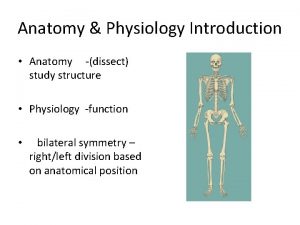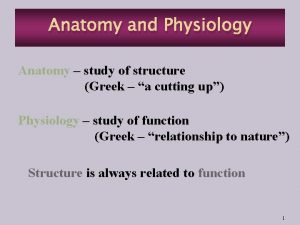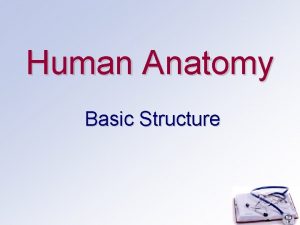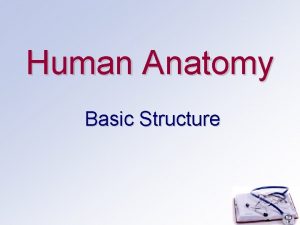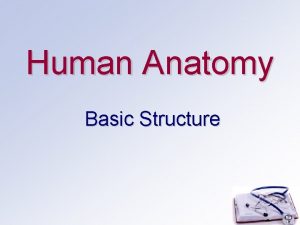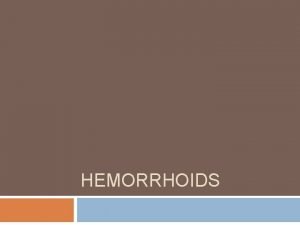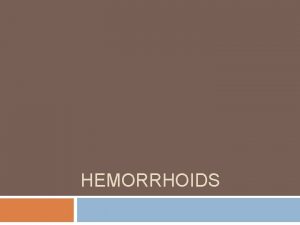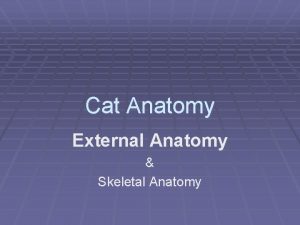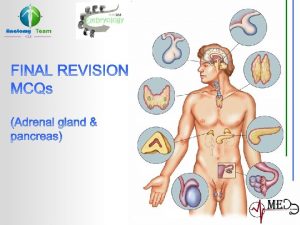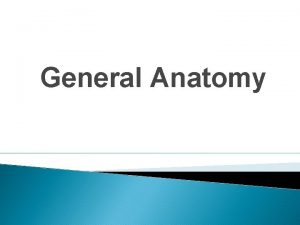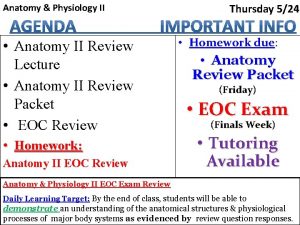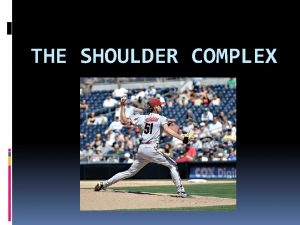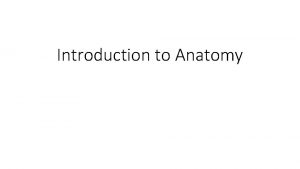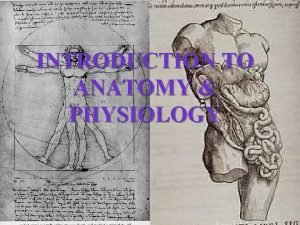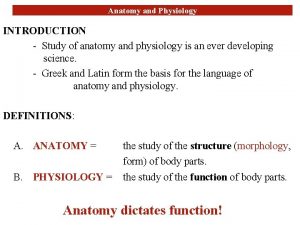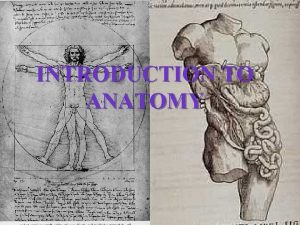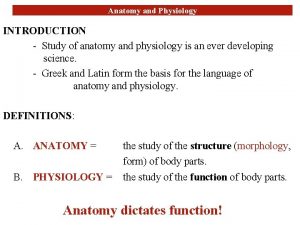Introduction to Anatomy Study of the structure of






















- Slides: 22

Introduction to Anatomy Study of the structure of the body in health Science of the strucure & function of body Is the foundation of the medical knowledge Comes from Greek word anatome– body cutting ` Subspecialties of anatomy Gross anatomy-as seen with a naked eye Histology- studies tissues using microscopy Cell biology- studies cells using microscopy etc Neuroanatomy-studies nervous tissues Embryology- study of embryo development

Gross anatomy Also known as macroscopic anatomy studied by dissecting the cadaver. The dissection is guided a manual. Can be regional or systemic approach At MUHAS we use the regional approach The body is divided into 6/7 regions -the upper limb -head and neck -abdomen -thorax -lower limb. -pelvis and perineum

Regional approach Studies the boundaries, contents, structures etc. in a a particular region Including: bones, joints, muscles, fasciae, blood vessels, lymphatic, drainage, nerves. Systemic approach Divides the body into various systems Osteology-bones Myology-muscles, Arthrology-joints Angiology-blood vessels Neurology– nerves Digestive system Urinary system, Reproductive system Endocrine system

Methods of study of Gross Anatomy -Dissection and observation (cadaver) -Radiography -Ultrasonography/Ultrasound/ -Computed tomography (CT), -Magnetic Resonance Imaging -Angiography -Endoscopy -Surface anatomy

Cell biology Is studied by using: -Light microscopy -Immunohistochemistry, -Electron microscopy -Immunocytochemistry -Flow cytometry -Molecular techniques -Fluoresent in situ hybridization (FISH) Histology Is basically studied by light and electron microscopy Developmental anatomy deals with the development of a baby from fertilization to birth. Neuroanatomy/Neurology Is the study of the brain spinal cord and nerves

The language of anatomy Anatomy has special terminology Comes from Latin/Greek e. g. : Lavetor-elevate/raise Labium-lip Pollicis-Pollex/thumb Peri- around Halucis halux-big toe Anatomical position Standing erect, feet together, arms by the side; head eyes, palms facing forward

Body Planes • Median plane A back to front vertical plane through the midline. Divides the body into equal right and left halves. • Sagittal plane Any plane parallel to the median plane Median is a form of sagittal planes Paramedian are typical sagittal planes • Frontal plane Any vertical plane at right angles to the median plane. Also called coronal plane. • Transverse plane Any horizontal plane at right angles to both the sagittal and frontal planes.

Terms of relationship Superior and inferior A structure closer to the head than the other is superior; structure away from the head is inferior. In embryology the term cranial replaces superior whereas caudal replaces inferior. • Anterior and posterior A structure nearer the front of the body is anterior; whereas the one nearer the back is posterior. In embryology ventral replaces anterior; and dorsal replaces posterior. • Medial and lateral A structure closer to the median plane is medial A structure away from the median plane is lateral A structure exactly in the midline is median.

Terms of relationship. . . • Proximal and distal This is applied mainly to the limbs. A structure nearer to the point of attachment of the limb is proximal, a structure away from the attachment is distal. • Supine and prone Supine refers to the body lying on its back Prone refers to the body lying on its face. • Superficial and deep/profundus A structure nearer to the surface than the other is superficial. A structure away from the surface is deep or profundus.

Terms of relationship. . . • External and internal A structure outside a cavity is called external; when it is within a cavity it is called internal. • Ipsilateral and contralateral Ipsilateral refers to the same side of the body Contralateral refers to the opposite side of the body • Some combinations e. g. Anterolateral Posteromedial Superomedial etc

Terms of movement… • Flexion Movement that decreases the angle of a joint. (mvt in a sagittal plane) Extension: Movement that increase the angle • • Abduction Movement away from the median plane Abduction of the fingers refers to spreading the fingers • Adduction Movement towards the median plane of the body • Opposition Specific movement where thumb tip touches another finger tip e. g. when holds a pen, grasp a cup handle etc • Reposition

• • • Terms of movement. . . Protraction: Movement forward as in moving the jaw forward Retraction: Movement backward as in moving the jaws backward or in drawing the shoulders backward. Elevation: Moving a part superiorly example the shoulders are elevated when raising the upper limb above. Depression: Opposite of elevation, moving a part inferiorly Circumduction: A combination of flexion, abduction, extension and

Terms of movement… • Eversion: The plantar surface of the foot is turned away from the median plane (turning outwards) • Inversion: The opposite of eversion; plantar surface is turned medially(turning inwards) • Supination: Rotation of the forearm laterally • Pronation: Rotation of the forearm medially

Elements of Osteology is the study of bones Functions of the bone • Support and protection The skeleton (bones, ligaments and tendons) supports and protects soft tissues • Muscle attachment and locomotion • Production of blood cells • Mineral reservoir

The skeleton • Axial skeleton -Skull, hyoid, vetebrae, ribs and sternum. • Appendicular skeleton -Bone of upper and lower limb + shoulder and pelvic girdle

Macroscopic features of bone • On cut surface the bone portrays(2 forms) – Compact bone-the outer cortical layer and, in flat bones termed tables – Cancellous/spongy bone-- inner trabecular layer with marrow-filled spaces. In flat bones of skull they are termed diploè • Periosteum- Membrane that covers the bone externally • Endosteum- Membrane that covers the bone internally These membranes contain osteoprogenic cells They are important in bone healing

Types of bones • Long bones- humerus, radius, ulna, metacarpals, femur, tibia, fibula, metatarsals, phalanges • Short bones- carpals and tarsal in hands and foot, scaphoid, lunate, talus. calcaneum • Flat bone- cranial bones, scapula, sternum, ribs and innominate • Irregular bones- vertebrae, temporal, sphenoid, ethmoid, zygomatic, maxilla, mandible, palatine and inferior nasal concha • Sesamoid bone- bones embedded in a tendon e. g. patella • Pneumatic bones- irregular bones with air filled cavities/ sinuses e. g. maxilla, sphenoid, ethmoid, frontal and mastoid part of the

Parts of long bones • Diaphysis- has a thick outer compact bone • Metaphysis- a thin part of diaphysis adjoning epiphysis • Epiphysis- proximal and distal rounded part

Terms used in osteology Bone surface have structures e. g. : • Elevations • Facets • Head and Condyle • Depressions • Foramen

Elevations • Linear elevations – Lines/ridges e. g nuchal line, supracondylar ridges – Crest is a prominent line/ridge • Rounded elevations -Tubercle- small rounded elevation -Protuberance- knob-like elevation -Tuberosity- big rough elevation -Trochanter- rough elevation of femur -Malleolus- harmer like elevation • Sharp elevation -Spinous process -Clinoid process

• Facet: Small, smooth, flat articular surface • Head and Condyle: Rounded articular surface normally covered by cartilage e. g head of humerus, condyles of femur • Epicondyle--prominent process just above a condyle

Depressions • Sulcus: Shallow and long depression on the bone surface. • Fossa: Deep depressions on the bone surface • Notch or Incisura: Semicircular depressions Foramen-Openings or holes Canal- A long foramen Meatus- canal that enter the bone but does not go through it
 Essay structure
Essay structure Hình ảnh bộ gõ cơ thể búng tay
Hình ảnh bộ gõ cơ thể búng tay Frameset trong html5
Frameset trong html5 Bổ thể
Bổ thể Tỉ lệ cơ thể trẻ em
Tỉ lệ cơ thể trẻ em Gấu đi như thế nào
Gấu đi như thế nào Tư thế worm breton là gì
Tư thế worm breton là gì Chúa yêu trần thế
Chúa yêu trần thế Môn thể thao bắt đầu bằng chữ f
Môn thể thao bắt đầu bằng chữ f Thế nào là hệ số cao nhất
Thế nào là hệ số cao nhất Các châu lục và đại dương trên thế giới
Các châu lục và đại dương trên thế giới Công thức tiính động năng
Công thức tiính động năng Trời xanh đây là của chúng ta thể thơ
Trời xanh đây là của chúng ta thể thơ Mật thư tọa độ 5x5
Mật thư tọa độ 5x5 101012 bằng
101012 bằng Phản ứng thế ankan
Phản ứng thế ankan Các châu lục và đại dương trên thế giới
Các châu lục và đại dương trên thế giới Thơ thất ngôn tứ tuyệt đường luật
Thơ thất ngôn tứ tuyệt đường luật Quá trình desamine hóa có thể tạo ra
Quá trình desamine hóa có thể tạo ra Một số thể thơ truyền thống
Một số thể thơ truyền thống Cái miệng nó xinh thế chỉ nói điều hay thôi
Cái miệng nó xinh thế chỉ nói điều hay thôi Vẽ hình chiếu vuông góc của vật thể sau
Vẽ hình chiếu vuông góc của vật thể sau Thế nào là sự mỏi cơ
Thế nào là sự mỏi cơ























